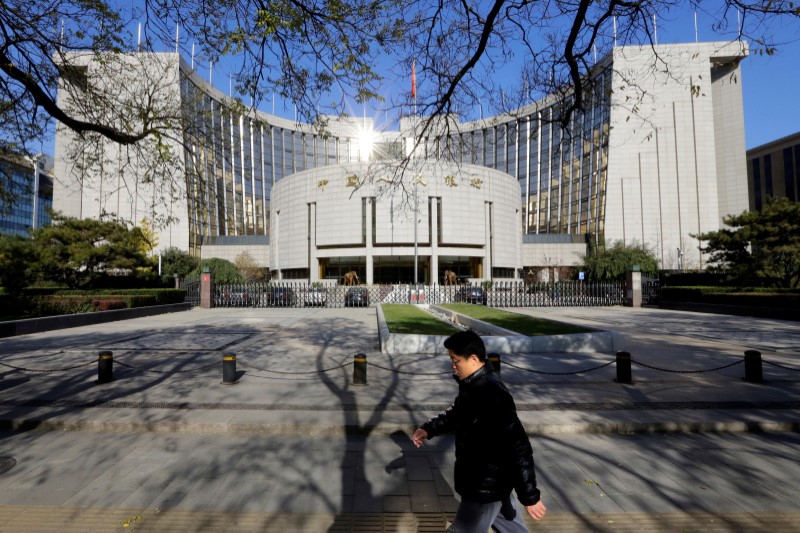 © Reuters. The Fed and the PBOC Are No Longer Poles Apart
© Reuters. The Fed and the PBOC Are No Longer Poles Apart(Bloomberg Opinion) — A pleasing synchronicity is edging back into the world economy, at least in terms of monetary policy. Let’s hope it’s not too late.
Wasn’t the “synchronized global upswing” narrative – all the rage in 2017 – retired last year? That doesn’t mean courses can’t be recalibrated. The signal late last week of a pause in interest-rate hikes from the Federal Reserve, an unmistakable shift, was preceded by a few hours China’s steps to shore up its slowing economy.
The world’s most powerful central banks are more aligned now than they have been for a while. I’m not just talking about the big two: The Bank of Japan is unlikely to formally adjust ultra-easy policy and the rate increase from the European Central Bank penciled in for this year looks increasingly like theory rather than practice.
The world economy can use the change. Growth is becoming dangerously lopsided with the U.S. still doing pretty well, albeit cooling from the 3.4 percent increase in gross domestic product clocked in the third quarter. That’s starting to look vulnerable. Indicators have been patchy: Job growth jumped in December alongside a steep decline in the Institute for Supply Management’s manufacturing index.
The past two years were characterized by the Fed hiking every three months, the ECB steadily withdrawing quantitative easing and the Bank of Japan pledging to stick by easy money – along with a nagging suspicion that Governor Haruhiko Kuroda wanted to dismantle some aspects of accommodation. The People’s Bank of China steadily cut bank reserve requirements in targeted ways and the Bank of England occasionally nudged rates around.
As 2018 wore on, there was less conviction in some of this: ECB President Mario Draghi almost apologized for wrapping up QE and the idea that the BOJ might end negative rates faded. Except for the Fed: America’s monetary chieftains kept plowing ahead. All the while, the global economic picture frayed.
With Fed Chairman Jerome Powell effectively announcing a breather Friday and China broadly reducing lender reserve requirements, a new framework is emerging.
The two largest economies are no longer pulling in opposite policy directions: one steadily moving toward restricting activity and the other trying to buttress it. It’s not quite convergence; the Fed is more likely to eventually raise borrowing costs again after a pause and China likely has further easing steps in the pipeline. But the gap between the two is no longer widening and that’s a big deal.
Stock-market ructions have taken their toll along with a poorer performance abroad and the trade conflict between Washington and Beijing. Europe’s expansion is dissipating and numbers last week showed a measure of Chinese manufacturing slipping into contraction. Emerging markets, generally, have been under pressure from the Fed’s tightening.
For all the superlatives about China’s rise and how that’s transformed global commerce, when it comes to monetary policy the Fed still matters more than any other authority. A unipolar financial world isn’t necessarily a great thing and it tends to obscure how interconnected the biggest economies are on the ground. The U.S. can’t stand completely isolated.
The Fed has long recognized this; now it’s about to be put into practice. One of the most telling lines in Powell’s fireside chat Friday with his two immediate predecessors, Janet Yellen and Ben Bernanke, was his reference to 2016. The Fed began 2015 and 2016 projecting four interest rate hikes in each of those years. It did only one apiece. The principal reason for proceeding with caution was softness abroad, including China.
The Fed was panned then for inconsistency and mixed messages. In retrospect, it was the right decision in both cases. There’s little point in simply charging ahead when circumstances change. Officials could do a lot worse than rewind the tape from 2016.
Fusion Media or anyone involved with Fusion Media will not accept any liability for loss or damage as a result of reliance on the information including data, quotes, charts and buy/sell signals contained within this website. Please be fully informed regarding the risks and costs associated with trading the financial markets, it is one of the riskiest investment forms possible.
Source: Investing.com






























